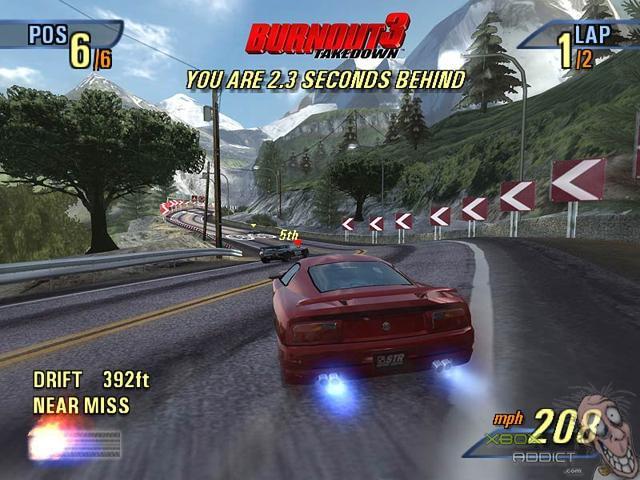


Because you can smash traffic going your way, it's easy to ram a car into cross traffic, causing a wreck there, while driving along to the next intersection to cause chaos on your own, in short creating multiple areas of destruction. Usually it involves the aforementioned checking. Many of the junctions are quite tricky, and you'll probably have to retry them a few times to discover the right way to get a gold medal. There's even a Madden-esque launching system that is like kicking a field goal Ц a 3-click system sets your takeoff speed, and you actually have to take wind into effect, as cars will move around in the air if you hit a ramp, and cars have different weights so lighter cars will swerve a lot while heavy ones won't. Criterion took out the various pickups from Burnout 3, instead making the junctions far bigger and more complicated. Traffic checking also comes into play with the revamped Crash mode, which arguably has become the trademark of the franchise. Right off the bat when you start the single player mode, World Tour, you're introduced to this reworked element with new game mode Traffic Attack, where the goal is to check as many cars as possible, before running out of time Ц seconds are added to the clock as you make contact, and more time is added if you use the smaller car to wipe out the larger vehicles. In exchange, there's far more traffic this time around to deal with, making some courses overloaded with danger if you wind up slamming into a bus or a truck, or even oncoming traffic Ц which is still a no-no in Burnout's world. As long as the car is reasonably sized and going the same direction as you, you can freely hit them, whether its to push them out of the way, or knock them into opponents as a method of taking them out, called 'checking' Ц think of a hockey check.


With Revenge, Criterion has made a sweeping change Ц letting you use the traffic as a weapon. In previous games, the traffic was an enemy, and the fear of rounding a corner and slamming into them was one of the things that made the game stand out from the pack Ц and in many ways, was a more dangerous opponent than the cars you race against. Much of Burnout Revenge is an evolved or reworked version of Burnout 3, most evident in Burnout's most vital aspect Ц how you deal with traffic. It's not the revolution that Takedown was, and arguably is the first step backwards for the franchise in relative terms, but no matter, Revenge is an amazing driving game with so much new and fixed up it feels almost like a whole new game in places. Unwilling to rehash the 3rd game, Criterion has again revamped the formula, making for a game that plays very differently from its predecessors in most aspects, though at the same time it's the Burnout you know and love. A year later, Burnout returns with the new Revenge subtitle, emphasizing the battle racing the game personifies.
Burnout 3 takedown ps2 profile name crack#
Mixing in a high level of terror, racing around tracks at high speeds with traffic all around with the ability to 'take out' opposing cars, or causing as much mayhem as possible in Crash mode, Burnout 3 was the runaway racing game of the year (some even thought it had a crack at overall game of the year, it was that well received), even if it was a dull year for the genre, and possibly the new benchmark to boot. The original games were good, if not great titles that demonstrated potential for Criterion's arcade racer, but Burnout 3: Takedown was the ultimate culmination of the ideas brought to the table. After a pair of installments that languished under the Acclaim name, Burnout had a breakout year in 2004 under the Electronic Arts banner.


 0 kommentar(er)
0 kommentar(er)
